人教版新目标初中英语八年级下册Have you ever been to an amusement park说课稿7篇
-
- 页数:40页
- 字数:约 40107 字
- 大小:276.00KB
- 格式:.doc
- 版本:Office2016及以上版本
- 作者:雨森设计
Have you ever been to an amusement park说课稿7篇
Have you ever been to anamusement park? 第一课时说课稿
一、教材分析
1.教材的地位及作用:
本单元围绕谈论过去的经历,学习使用现在完成时态。通过对学生们喜闻乐见的一些娱乐场所(fun places)的描述,反复运用句型Have you ever beento…?

I’ve never been to…. 来激发他们使用本单元所学单词的兴趣。教材中提供的所有活动都以现在完成时态为中心,通过一系列的听、说、读、写的训练,来加深对现在完成时态的理解,明白英汉两种在结构及表达方法的一些异同点。从而提高他们运用所学语言的综合能力。
2.教材的结构
本单元分Section A 和Section B 两部分。Section A 中通过所设计的各项任务呈现了两篇听力课文和一篇阅读理解。Section B则安排了一篇听力和两篇小短文,用以加强对目标语言的理解。Self Check 部分是用来检查学生对本单元所学目标语言的综合运用能力。单元后的语篇训练旨在通过目标语言培养学生的阅读理解能力,掌握一些基本的阅读技巧。
3.教学目标(知识目标、能力目标、情感目标)
1)知识目标:
学习单词:Section A----space museum, amusement park, aquarium, boat, water park,theme park, neither;
Section B----English-speaking country, language, flight attendant, tourguide, used, improve;
Self Check----understand, decide, rent, show, special
掌握句型:Section A----Have you ever been to an amusement park?
Yes, I have. / No, I haven’t.
I’ve never been to a water park.
Me neither. / Me too. / So have I.
Section B----I want to understand English language movies.
I want to study in an English-speaking country.
It’s fun to learn another language.
I have to.
I want to travel.
2)能力目标:训练学生运用所学知识进行听、说、读、写的综合能力。
3)情感目标:引导学生学会与别人分享快乐,发现身边的美好事物,从而树立正确的人生观和价值观。培养学生学习英语的强烈兴趣,意识到合作学习的重要性。
4.重点和难点
重点:1)掌握本单元的目标语言Have you ever beento…? / I’ve never been to….
2) 记忆本单元的主要单词。
难点:1)比较现在完成时态与一般过去时态的异同。
2)听力课文中关键单词、短语及句子的理解。
3)帮助学生掌握阅读课文中的难句。
二、说教法
在课堂教学中建立平等、民主、和谐的师生关系;切实转变教师的教学方式、学生的学习方式以及教学内容的呈现方式;重视师生互动、倡导合作学习;加强信息技术与学科课程的整合,运用多媒体教学手段辅助教学,注重实现教学方法的优化组合。
1.任务型教学法:这是新课标所倡导的新的教学理念,引导学生在完成任务的过程中“用中学,学中用”。例如,将Self Check中的表格整合到第一课时中,完成1c后要求学生在小组内进行调查,培养学生运用目标语言解决实际问题的能力。
2.情景教学法:在课堂教学中,借助多媒体手段呈现一些图片、动画及资料,创设生动直观的教学情景,激发学生的学习兴趣。
3.合作探究法:例如在Section B中,围绕Why do you study English?组织学生共同探讨,鼓励学生们给出各自不同的答案,总结出学英语的重要性。
4.新旧知识对比法:在语法教学中采用传统的问答方式,让学生体味一般过去时与现在完成时的异同,从而进一步加深对目标语言的理解。
三、说学法
学生是学习的主体,教学中要加强学法指导,让学生学会学习,关键是转变学生的学习方式,让学生成为学习的主人。
1.预习法:课前安排学生阅读教材内容,找出重难点,提出问题。并带一些去各地游玩的照片,利用身边的有效资源来加深对目标语言的理解。
2.合作法:通过分组练习,使得人人开口说英语,用英语,培养他们积极参与,善于合作的团队精神。
3.角色表演法:例如在Section B中,设计一次互相采访,让学生在具体的语境中体味目标语言的真实性。
四、说流程
1.总体设计及课时分配:
1)Section A涉及两篇听力课文及一篇阅读理解。按先输入,再输出的原则,以Have you ever been to …? / I’ve never been to. …为知识中心设计一系列听、说、读、写的任务,由浅入深,由易到难,谈论学生喜闻乐见的一些娱乐场所,使学生学会运用现在完成时来谈论过去的经历。计划3课时完成。
第一课时(1a-1c)以key vocabulary 和理解Present Perfect Tense 的结构为主来设计任务。从单元的整体框架来看,这部分是一个介绍和导入部分,主要的目标语言及话题在这一部分呈现。可采用以旧带新的方法来呈现现在完成时的结构。所选材料来源于现实,为学生所熟悉,能引起学生的学习兴趣。尤其是课本上所提供的问题及画面能强烈刺激学生的感官,调动起他们的求知欲。
第二课时(2a-2c)通过对上一课的回顾,以一幅城市的旅游地图开始设计任务。以三小段听力谈话为中心,使得目标语言在这一部分得以延伸。加之适当的语法总结和语言点的精讲,能使学生对Have you ever been to…? / I’ve never been to… .更加清楚。将Pairwork部分设计成一任务能更有效的帮助学生理解目标语言。
第三课时(3a-4)这是一篇长课文“Have you ever beento Disneyland?”。着眼点并不是对文中语言点的讲解,而在于整体掌握文章的结构及基本的写作手法。可根据文章设计一系列问题,让学生通过合作,自主去寻找、发现答案。通过组织Pairwork和Groupwork来传授目标语言在语篇中的运用。
2)Section B包括一篇听力和两篇短文。设计一次采访任务的角色表演和小组合作学习探讨的模式,从而加深学生对现在完成时在具体真实语境中的理解。拟2课时教完。
第四课时(1a-2c)第一部分以Why do you studyEnglish?为话题,鼓励学生给出不同的有趣答案,充分调动课堂学习气氛。而第二部分的听力,让学生捕捉目标语言在真实语境中的具体运用,以及与其它时态的对比。拟用Pairwork来设计一次采访任务,这对学生则充满着挑战。可通过适当的引导,给出问题,化难为易。
第五课时(3a-4)有两篇短文。重点应放在使用目标语言的写作能力训练上。3a可设计成限时阅读竞答,把学生分成几大组来抢答课文中的8个问题。然后通过多媒体适当呈现文章中的一些重、难点,强化记忆。可将4调到3b-3c之前为3b-3c的写作扫清一些障碍。该写作练习有点难,但可以帮助学生养成即时使用目标语言及词汇写作的习惯。
3)淡化语法不等于不讲语法,所以在Self Check中设计成一堂语法与写作课,比较现在完成时与一般过去时的异同,通过练习进一步巩固学生对目标语言的理解和运用。此为第六课时。
4)最后一篇阅读理解仍然以目标语言为话题,教会学生一些阅读策略。1课时可完成。
2.教学过程设计:
第一课时:1)导人:利用多媒体展示自己在一些地方游玩的照片,如长城、故宫、上海等,每次都提出Have you ever been to…? 引导学生集体回答Yes, I have./ No, I haven’t.I’ve never been to… 这样的热身活动可激发学生的学习兴趣,对即将要学的目标语言有个初步预知。然后导入本单元课题,切入本堂课的三项任务:Remember Key words; Present Perfect Tense; Listening and Pairwork.
2)Remember Key words将课本中的娱乐场所剪切到屏幕上,通过看图、领读、齐读、背诵、默写,给学生形成强烈的感官刺激,强记本节课的关键单词和短语,为后面的两项活动做好铺垫。
3)Present PerfectTense展示现在完成时的基本结构,学生在第六单元已经学习了现在完成进行时,所以对所给出的现在完成时应不太陌生,通过几幅图片的展示及例句的讲解,使之明白可以使用现在完成时来谈论过去的经历。为后面的Listening and Pairwork扫清语言结够上的障碍。
4)Listening播放听力前要求学生对课本图画上的对话进行朗读与强记,化解了听力中的难点。这时再播放两遍听力,一遍听,二遍做,完成1b已变得十分轻松了。这同时也为接下来的Pairwork所需语言结构提供了模式。
5)Pairwork 将活动1中的图片调出反复播放,按1c要求做 Pairwork. 此时教师可深入学生当中,解决他们交流中的一些实际问题。然后请几组学生按展示的图片进行Role Play。该活动的目的是从口语和听力上再次强化了学生对本单元目标语言的理解。
6)Make a Survey 将Self Check中的表格整合到这节课,考察学生运用目标语言解决实际问题的能力。
7)小结与作业调出屏幕上本节课的三项活动图片,总结本堂课内容,强调重难点,使学生对本堂课的知识线有个总体的掌握。布置复习与预习的作业,要求他们下节课带到各地游玩的照片,为下节课的活动做好准备。
8)板书设计
Unit 9Have you ever been to an amusement park?
Task 1 key wordsTask 2 Present Perfect TenseTask 3 Listeningand
space museum have / has + P.PPairwork
amusement parkI have ever been to…
aquarium Have you ever been to…?
zoo Yes, I have./ No, I haven’t.
water parkI’ve never been to…
五、教学反思
以导入为突破口,精心设计的导入可以激发学生的学习兴趣,使他们很快融入到英语学习的氛围当中来。以学生为中心,让学生在完成任务的过程中达到掌握本节课的目标语言。据此设计了记忆单词、目标语言呈现以及听力与分组练习三项具体的任务。一个任务的完成是下一个任务的前提条件,由易到难,前后相连,层层推进,从而形成了本节课一个完整的任务链。从教材的安排体系来看,似乎是以听力材料为中心,但我认为着重点还应落实在Pairwork上。本着听说领先的原则,将Selfcheck中的活动2整合到该课时,以期达到听、说、读、写全面发展的目的,真正做到“为用而学,在用中学,学以致用”。
同时一些传统的学习方法仍是语言学习过程中不可缺少的重要手段,如朗读、背诵、默写等等,应予以充分重视。因为没有一定量的语言知识的输入,任务型活动无疑是座空中阁楼。
任务型教学不应仅停留在为设计任务而设计任务的层面上,教师应从“学”的角度来设计具体的教学内容,充分体现以学生为主体,以人的发展为本的教育理念。激发和培养学生的学习兴趣,帮助他们树立自信心,养成良好的学习习惯,形成有效的学习策略,发展自主学习的能力和合作精神。
Have you ever been to anamusement park? 第一课时说课稿二
一、教材分析:
1、教学内容:
本单元是Go for it ( 下 ) Unit 9。主要围绕“Have you ever been to an amusement park?”这一主题展开各种教学活动,并以这一主题引出现在完成时的一般疑问句,否定句以及特殊疑问句等语言功能。本单元旨在创造一个轻松、愉快的学习、交流环境,通过听、说、读、写来培养学生综合运用这些知识的能力。并让学生能在“做中学”(learning by doing),通过有限的课堂实践活动,拓展以往的经历,能准确地用英语来表达。
2、教材的地位和作用:
八年级下九单元Have you ever been to an amusement park ?
讲述的是现在完成时的用法,这是初中非常重要的时态之一。学生们能够用现在完成时来表达自己的经历,来体会别人的感受是很重要的。这个单元一定要体会现在完成时的真正含义和用法。要避免混淆几个重点词组的使用。
我们更要使学生不仅理解枯燥的语法,还要让学生们会用新学的语法知识来表达思想。
3、教材的处理:
根据《英语课程标准》(实验稿)关于总目标的具体描述,结合本单元这部分的教学内容及基于对教材的分析,我对本单元的内容进行如下处理,目的是突出重点,使课堂节奏紧凑,衔贯。本单元分为四课时,第一课时是Section A,第二课时是Section B, 第三课时是Self Check, 第四课时是 Reading,最后一部分是做练习,以学生的自测为主,然后予以校对。
二、教学目标:
? 根据以上我对本单元教材内容的分析,我确定以下几个为本单元的教学目标:语言知识、语言技能、学习策略、情感态度和文化意识五个方面。
1.语言知识:
本单元要求学生掌握以下词汇(neither, theme, end up, especially, discover, population, simply, fear,whenever)
语言功能:
学习和增加阅读技巧和阅读策略。
语言结构:
Have you ever been to an aquarium ?
Yes, I have been to an aquarium.
No, I haven’t.
I’ ve never been to a water park. Me neither.
2.语言技能:
(1)能用现在完成时的各种形式进行准确的描述和表达过去的经历。
(2)能掌握现在完成时态中几个词组的正确使用,如:
have been to , have gone to , have been in 等。
(3)能在日常生活中恰当理解和运用本单元的话题范围内的单词和习惯用语。
3、学习策略:
通过本单元的教学,我要求学生能通过上下文内在的逻辑联系和在一定的语境中正确理解并运用现在完成时来准确地表达所发生过去的经历。
4、情感态度:
通过对本单元的任务性活动,我的目的是让学生们用英语描述他们过去的经历,同时能提高他们的观察能力和表达能力,激发他们对学习英语的兴趣和热情,在接近生活常态的交际中能乐于模仿,敢于开口,积极参与,主动请教。
5、文化意识:
通过他们描述过去的经历,了解一些西方国家的风土人情。
三、教学的重、难点:
基于上述对教材的分析,我确定本单元的教学重点为词汇、词组搭配和现在完成时的用法。
教学难点为现在完成时的含义和用法,能在交际中准确地运用现在完成时来描述或表达过去的经历。
四、教学方法:
1、教法分析:
(1)现在完成时是初中非常重要的语法项目,而本单元的话题源自生活,立足这一点,我充分利用学生已有的知识和生活经验,让他们讲述去过的国家或地方,创设生活化的真实情境引导学生在运用语言中学习语言,然后在学习新的语言知识后创造性地运用语言(为用而学,在用中学,学了就用)。
(2)开展多种类型的任务型活动,提供给学生合作交流的空间和时间,促使学生为完成任务和同学进行合作,为完成任务进行探究性学习。
2、学情分析:
我们教学的对象是初二学生(好,中,差等生都有),他们学习英语既感到好奇又担忧,希望能得到他人的肯定。因此我在教学活动中尽量让他们参与到活动中来,有更多的机会来说英语,减少他们的恐惧感,通过学生间的合作学习,降低他们的学习难度,使他们体验到成功的喜悦。同时在阅读和书面表达中加以落实,提高他们综合运用语言的能力,使各层次的学生都有所收获。
五、教学过程设计
Unit 9
The First Period (Section A)
Step 1 Warming up
(“良好的开端是成功的一半”,因此,我认为能以一种新颖的问候方式或复习方式进入一节课,就能唤起学生的兴趣,使学生保持一种积极的学习状态,或循序渐进地导入所学的内容,那么可为这节课的成功打下基础,同时也能给自己适当的减压。)
T:I like travelling. I have been to Dalian and manybig cities. What about you ?
接下来教师让几个学生讲述他们去过的城市或国家,让其他学生用英语来猜测。(目的是为本节课的现在完成时作好铺垫)
Step 2 Presentation
教师出示几张图片,引出现在完成时的结构和用法。
T: Have you been to an aquarium ?
Yes, Ihave.
T: Have youbeen to a water park?
No, I haven’t.
这样设计的目的是让学生在交际情景中感受出现在完成时的结构和用法。
然后叫学生归纳出现在完成时的结构句型。
主语 + have/has + 动词的过去分词
(培养学生归纳能力,找出记忆的规律。)
Step 3 Practice
1. Show some pictures and let the students ask andanswer in pairs.
A: Have youever been to an amusement park ?
B: Yes, Ihave. Have you ever been to a water park ?
A: No, Ihaven’t.
2. Practice Section A (1a)
Step 4 Listening
接下来的任务型听力要求学生对现在完成时加深理解,教师可承接刚开始的话题,引导学生根据所学语言完成以下任务:
(1)听力练习,让学生完成1b,填写表格。
(2)然后看图,完成2a ,进行判断正误练习。
S1: John has never been to the space museum(T)
S2: Linda has been to the aquarium. (F)
(通过听力训练,现在完成时的结构得以很好的落实)
Step 5 Reading ()
让学生阅读主题公园的一篇文章,圈出他们认为有趣的地点,事情和活动。
(1)四个人一组合作学习,更好,更快地回答问题,加强对文章的理解。
(2)然后叫学生再阅读一遍文章,做一个对话练习。
(3)本部分要求学生掌握一些固定的词组搭配,如: around the world, end up , take different routes 等。
Step 6 Group work (形式到位,具体任务不明!)
接下来我设计的任务是要求四个学生为一小组,进行问答练习。
如:Have you ever studied with more than three friends? Have you traveled to another province of China ?
Have you helped someone you didn’t know ?
(这样的活动既可以培养学生的合作意识,又能在情景中用现在完成时交际,巩固了本节课的重点,从而突破了难点,促使学生在学习过程中体会理解。)
Step 7 Summary and exercise
Section A Difficult points
“have been to”
means you went somewhere before , but now you arestill here
“have gone to”
means “you leave here already , you aren’t here.”
Homework:
1.熟记本课时的单词,词组和重点句型.
2. 在上述小组活动的基础上,再要求学生完成一份调查表,目的是为下面的写作作好准备.
3.要求学生写一篇关于去过某地和一些经历的文章。在以上的学习过程中,学生以具备了阅读和处理相关信息的能力,因此这部分任务交给学生自己完成,以此提供学生运用语言,解决问题的空间.)
写作是学生综合运用语言能力的体现,通过写作能强化语言的运用,同时加深对所学知识的理解,将学与用融合.)
4.要求学生为下一节课准备照片,进行问答练习(Tell the group about your photos.)(这样的小组活动,有利于培养学生的合作,又能让学生在实践中学习,在交流中运用语言.)
教学设计理念:
1、教学活动始终遵循任务型教学的教学理念,以学生为学习的主体,以任务为中心,在运用语言完成任务的过程中来学习,体会和掌握语言。
2、自始自终贯穿了以交际为目的的原则(在做中学,在学中用)。
3、在教学过程中,关注学生的生活实际和生活体验,让其贴近实际、贴近生活、贴近时代,树立以学生为本的思想,提倡学生参与、体验、亲身实践、独立思考、合作探究,从而实现教学方式和学习方式的转变。
Have you ever been to anamusement park? Section A说课稿
一、说教材
(一)教材分析
本单元的话题“Fun places”,通过本单元的教学,帮助学生掌握描述过去经历的功能句式,学习现在完成时的用法,并能区别现在完成时和一般过去时在表述过去经历时的不同。Section A 1a 呈现了几个有趣的地方,要求学生根据自己的兴趣给它们排序。该活动不仅帮助学生学习新词汇,同时也能激发他们的学习兴趣。1b 是一个听力活动,初步呈现了本单元的目标语言,即现在完成时。要求学生听录音对话,判断 Claudia 和Sarah 分别去过哪些地方。1c 是一个口头练习,学生将结对用目标语言对图片中的几个地方进行对话练习。2a 和2b 是2个听力活动,学生将听到三个对话,要求学生能将听到的地名圈出来,并根据所听内容判断一些句子的正误。2c 是会话活动,要求学生根据听力活动中的对话做角色扮演,谈论去过哪些地方,想去哪些地方以及打算如何去。
(二)教学目标
1.知识目标
1)重点词汇和短语:amusement park, space museum , aquarium,zoo, water park , neither, have a great time
2)重点句型:
Have you ever been to…? Yes, I have been to… /No, I haven’t. / Me neither
2.能力目标:使学生能够用现在完成时谈论他们去过的地方
3.学能目标:帮助学生学会怎么样谈论他们去过的地方
4.德育目标:通过对本课的学习,使学生了解各地的一些名胜古迹,加强学生对社会主义祖国的热爱,并从中学会人际交往。
(三)教学重点和难点
1.重点:掌握本课重点词汇和句型
amusement park, space museum, aquarium,water park , neither,
have a good time
Have you ever been to….?
Yes, I have been to…/ No, I haven’t. I … / Me neither.
2.难点:使学生能用目标目标语言谈论他们去过的地方及区别现在完成时与一般过去时的不同。
理论依据:根据英语课程标准的规定,通过听,说,读,写的训练,使学生获得英语基础知识和初步运用英语的能力,激发学生的学习兴趣,为进一步学好英语打下初步基础。
二、说教法
1.根据新倡导的“用英语教英语”的教学法,尽量用英语来组织课堂教学,创造英语课堂良好的听的环境,让学生充分感知,积极检验,大胆实践,把握用英语交际的机会,鼓励学生大胆说英语。
2.任务型教学法,通过体验,参与,合作与交流的学习方式,独立学习,小组学习等学习形式,培养学生自主学习的能力,培养学生互相帮助,关心他人,积极思考,判断辨别的能力及张扬个性,培养创新能力。
3.情景教学法:创造足够的交际环境刺激学生的视听能力,使学生更好掌握目标语言
4.交际教学法:语言学习贵在运用。教学过程中必须通过大量交际实践,学生才能做到脱口而出,采用轻松,愉快的教学方法调动学生的主动性和积极性,使学生乐于开口,敢说想说。
三、说学法
1.学会预习。发挥学生的主观能动性,变被动学习为主动学习。带着目的听课,能更好地掌握知识重点与难点,提高课堂效率。
2.合作学习。积极的小组对话或活动,相互交流,互相帮助,合作完成任务,培养团队精神,更好地掌握所学知识。
3.为用而学,在用中学,学了就用。善于抓住用英语交际的机会,充分感知,联系实际,积极体验,大胆实践。
理论依据:教学方法是教学过程整体结构中的一个重要组成部分,是教学的基本要素之一,教学方法直接关系着教学工作的成败,教学效率的高低和教学目标的实现。因此,教学方法的选择与运用,是能否实现教学目的,完成教学任务的关键。科学地选择和使用教学方法能调动学生学习的积极性,主动性,激发学生的学习兴趣和求知欲,能在不加重学生负担的基础上全面完成教学任务。因此,根据本课时的语言目标,功能目标,我确定了以上教学方法。
四、说教学过程
Step 1 导入新课
一堂好的课首先要有一个好的开头。良好的开端是成功的一半,成功地导入教学,可以激发学生学习的兴趣,调动学生学习的积极性,使学生进入最佳学习状态,提高教学与学习效率。本课是谈论过去的经历,因此我通过以下对话来导入新课。
1.T: Were you happy last Sunday?
S: Yes, I was.
T: Where did you go ?
SA: I went to the zoo . / water park/amusement park…
T: Did you have a great time?
Ss: ….
T: Have you ever been to the zoo / waterpark / amusement park…
SB: Yes ,I have. I had a great time there.
SC: No, I haven’t. I have been to….
把本课的重点词汇和目标语言板书,带读并讲解。这样,让学生对即将学的语言知识有个初步的了解。
2.在学生基本熟悉这一目标语言后进行句型游戏,其操作如下:
以小组为单位,前排的学生问后排学生,后排学生答完接着往下问,直到最后一位同学。所用句型如下:
SA:Have you ever been to ….?
SB:Yes , I have. / No, I haven’t.
SB:Have you ever been to ….?
SC: Yes, I have…
3.1a, 读1a中的词汇并根据自己的兴趣进行排序。然后朗读1a中的句型。
通过以上操练和朗读,让学生更加熟练所学句型。
Step 2 Listening
根据新课标,英语教学要使学生听,说,读,写的能力得到全面发展,听是很重要的,也是必不可少的一个环节,在学生初步体验新知识后,及时进行听力训练,可以收到良好的效果。因此,我设计以下教学活动:
放录音,让学生听并完成1b. 2a. 和2b的教学任务。
Step 3 Pairwork and groupwork (1c and 2c )
通过设计适合学生开展的结对活动,让学生彼此交谈,学生就有更多的时间来使用新语言,又不感到枯燥,短时间内向学生提供了大量的操练与交际。我设计以下活动。
Task 1:让学生拿出他们去旅游时照的相片来进行问答,如:
Have you ever been to …?
Yes, I have ./ No, I haven’t. I have been to …
Task 2:拿出一幅中国地图,让同学们谈论都去过什么地方,以小组为单位,每个小组选一个同学做记录,把谈论的结果都记下来,最后让小组长汇报谈论结果,看哪一个小组的同学去过的地方最多,表达得最准确,进行比赛。所用的句型如下:
A: I have been to … Have you ever been to …?
B: I went to the … last year .
C: I am going to … next year .
记录员的汇报如下:A has even been to …. B and C have been to… D and E are going to… next year.
Task 3:让学生用所学的句型根据自己的情况进行自由对话。例如:
A: Hello, have you ever been to….?
B: No, I haven’t. How about you ?
A: I have you ever been to…. It’s very beautiful. I have a good timethere.
B: It sounds very good . I am going to … next year .
….
这样设计的目的是为了让学生在实际的交际中灵活地运用语言。
Step 4 Exercise
用 Have been to 造句,把所学知识体现在写的训练方面,有助于巩固学生所学的知识。
Step 5 Homework
用目标语言仿照1C编两组对话(肯定和否定)
板书设计
Have you ever been to an amusement park?
amusement park Have you ever been to … ?
space museum Yes, I have . I went to …
aquarium No, I haven’t.
zoo I have been to…
water park Me neither.
neither have a great time
Have you ever been to anamusement park? Section A英文说课稿
Good morning, commentators and teachers.Nice to meet you!
Today I am going to talk about Have youbeen to an amusement? Section A, PEP Primary English ,Go for it, Book 4.This lessenis a new part in the unit. We will learn the Present Perfect Tense and a newsentence pattern “Have you ever been to…?”And We will learn to talk about past experiences using the knowledge andlearn the important culture in the western countries----Disneyland.
I think this lessen is a spoken class andreading class. I not only help students to express the past experiences inEnglish, but also I cultivate the students’reading skills andwiden their English knowledge..
As we all know: the main instructionalaims of learning English in primary school is to cultivate students’ basicabilities of listening and speaking and reading and writing and their goodsense of the English language.
So in my teaching process , I try to helpthe students to remember new words and learn the teaching difficultpoints---the sentence pattern by using the Five step method, audio-video,communicative approach and task-based learning method. At the same time, I trymy best to use all kinds of methods such as multi-media computer, the tape andpictures to make the teaching difficult points easier and make students learnmore interesting and more effective in class.
In my teaching process I’ll finish thislesson in five steps.
Step one: Speaking ability
I show some pictures of places to thestudents by using multimedia , at the same time, I explain the new words ofthis lesson and help the students to memorize the words(amusement, aquariumetc).Then I ask the students the question and make a conversation like this:
-----Have you ever been to…?
-----Yes, I have. / No, I haven’t.
And help students to understand thesentence pattern. After the example, I help students make a similar dialogueusing the places.
Step two: Listening ability
After talking about the topic, let’s finish listening practice1b,2a,2b. Listen to the tape again and again.Try to help students understand the meaning of the conversations. Pay attentionto the intonation and pronunciation. And I give some additional questions aboutlistening materials:
-----Has Claudia ever been to an amusementpark?
-----Yes, he has. /No, he hasn’t.
-----Has Sarah ever been to a water park?
-----Yes, she has. / No, he hasn’t.
Step three: Reading ability
After finishing the listening, I show somepictures about Disneyland, Mickey Mouse, Donald Duck and ask some questionsabout them, then lead to the reading material on page 70. At the same time, askstudents to answer the following questions:
a. Have you ever been to Disneyland?
b. What can you do in Disneyland?
c. Would you like to go on a DisneyCruise?
By reading the text and answering thequestions, students can understand a little about the text, then I explain somekey points.
Step four: Review
Please look at the table on Page 70. Thestudents discuss the form and make a survey of their partner about thesequestions in order to master the sentence pattern “ Have you ever been to…. ?”
Step five: Classroom work and homework
1) Classroom
1.——Have you ever been to _____ amusement park?
——Yes, I have.
A. a B.an C.the D. /
2.——_____ you _____ to a water park?
A. Have ; gone B.Have ; been C.Has; been D.Has; gone
3.I don’t like those coats because ______of them fits me.
A.either B.neither C.none D.all
4.He_____ been to Shanghai.He _____ there last year.
A.have; go B.has; go C.has; went D.have; went
5.He hasn’t been to Beijing.He ______ there next year.
A.goes B. went C.will go D. has been to
2) Homework
a. Read and retell the text of Page 70
b. Practice the sentence pattern with classmates after class.
Blackboard writing
Have you ever been to an amusement park?
key wordsPresent Perfect Tense
space museum have/has done
amusement parkIhave ever been to…
Acquire Have you ever been to…?
ZooYes, I have./ No, I haven’t.
water park
In the end, would you please give me somesuggestions about my lesson? Thank you for listening.
Have you ever been to anamusement park? Section B说课稿
一.设计思想
本节教学主要内容为Unit9 section B部分,教学目的是:在学习了Section A
基础上对“ Have you ever .. .. ..?”句式结构的巩固、扩展及综合运用,并使学
生在活动(完成任务)的过程中能够创造性活用所学语言——谈论过去的经历。
我在设计教学中,从内容安排来说基本按照 Section B 的顺序,所不同的是全部
通过任务的形式,并以对话、听力、阅读、写作为载体,把整节内容贯穿始终。第一步,以任务形式复习已学过的Section A部分,导入新课。即在小组内完成调查表格,并做汇报。第二步,以Pair work展开讨论并做汇报的任务形式学习1a 、1b。第三步,以听力练习为基础,完成汇报任务。第四步,采取小组竞赛得分的游戏形式,调动学生阅读积极性,使其积极参与到阅读和回答问题的活动中。同时,在竞赛过程中注意对学生参与意识及遵守课堂纪律的态度、情感方面的培养。第五步,以 Group work形式在小组内完成调查表格的任务,进一步巩固、扩展知识,使学生在活动中活用语言。另外,本节在设计上还采取“学案导学”模式,即每个学生手中有一份与教师教案同步,但内容是更好的帮助学生完成任务的学案,以辅助学生学习。
总之,本课的设计宗旨即是采用任务型教学模式,使学生在完成任务的过程中学会用语言,发展学生的综合语言运用能力。
二.教案
Have you ever been to an amusement park?(Section B)
Teaching Aims:
1. Learn to talk about past experience andreasons.
2. Learn to ask the others’ past experience and reasons.
Teaching Emphasis:
Review and enlarge the using of “Have you ever been to……?” and talk about the past experience
Teaching Aids: tape recorder & paperstudying
Teaching Content:
Step 1通过完成task,复习Section A部分的基本句型,为进一步学习 Section B做铺垫。
Task: 小组活动。根据所给表格,在各小组范围内了解同学们过去是否有过这些经历,并至少说出一个自己曾经有过的其它经历,完成表格,然后请一名小组成员做report.
Names
Have you ever.…..
Yes
No
The other experience
been to an aquarium?
traveled to another city?
helped someone you did not know?
studied English?
been to an aquarium?
traveled to another city?
helped someone you did not know?
studied English?
been to an aquarium?
traveled to another city?
helped someone you did not know?
studied English?
been to an aquarium?
traveled to another city?
helped someone you did not know?
studied English?
Report: In our group, _______ students havebeen to an aquarium, _______students have traveled to another city, ______students helped someone they did not know, ______students have ever studiedEnglish, and we have been studying English.
Step 2 Pair work
Task: 同学们都学习英语, 请同学们在组内自述Why do you study English?,并参看P71--1a, 向全班说which reasons are important to you, andwhich reasons are not important to you.( 1a, 1b)
Step 3 Listening
Just now the students told about why theystudy English, now listen to a tape and know what a interview between a teacherand a student. After listening complete these tasks.
Task1: Try to tell the words you can’t guess the meaning or understand .
(The teacher explain these words inEnglish, and write them on the board.)
Task2: Listen again, and circle thequestions you hear. ( 2a )
Task3: Listen the third time or onceagain, and fill in the questionnaire. ( 2b )
Task4: Pair work (2c )
Look at the questions in activity 2a and roleplay the interview.
Answer with the information that is truefor you.
Task5: Write a summary and report
Report: My name is ... , I’m from..., I want to study Englishbecause...
Step 4 Reading (Group work)
在规定的时间内读课文,以小组竞赛的形式回答课下8个问题,看哪组回答的问题最多,并且快而准确。
(1)在规定的时间内,分小组读课文,并探讨问题如何回答。
(2)强答问题,并记分。(回答正确加十分,错误减十分,由教师记分)同时教师讲解同学们把握不准的问题。
(3)以 Pair work 形式,让学生熟练掌握问题及答句,并站起来对答。
(4)大声朗读课文一遍。(有时间可多一遍)
(5)根据问题,简要复述课文
Step 5 Task在本组内调查, 通过对话完成P88表格,并每组请一名同学做最后汇报。
Have you ever…
Names
Visited an English-speaking country?
Spoken to a native speaker of English?
Written a letter in English?
Watched a movie in English without subtitles?
Read a newspaper, magazine or web page in English?
Used English on the Internet?
Step 6 Homework
Write an article about oneself for the schoolmagazine。(3b)
(注:下次课上前5分钟请同学读作文。)
Have you ever been to an amusement park
学习目标
1. Learn to talk about past experience andreasons.
2. Learn to ask the others’ past experience and reasons.
学习向导
Function
Talk about past experience
Target Language
Have you ever been to an amusement park?
No , I’ve never been to an amusement park .
Yes , I have . I went there last year
Structures
(1)Have you ever been to …?
Yes, I have. / Yes, I have ever been to …
No, I haven’t. / No, I have never been to …
(2)When did you go there?
I went there last year.
(3)I have never been to a water park.
Neither have I.
I have ever been to an amusement park.
So have I.
(4)How long have you been studying English?
I’ve been studying English since nine o’clock.
I’ve been studying English since I came back home.
I’ve been studying English for five hours.
(5)What’s that?
It’s an amusement park in Japan.
I’ve never been to an amusement park like it before.
It’s fun to learn another language.
Let’s go tonight.
Isn’t this great?
Key Vocabulary
Key Phrases
space museum, amusement park, water park, South America, Peru, Holland, European culture, tour guide, flight attendant, musical instrument, more than, be from, get to, take lessons, neither, discover, graduate, change
学习策略
思维技巧
Listening to specific information
Cooperating
多元智能
1.Disneyland 了解相关文化背景。
2.世界地理知识。
Recycling
复习相关的词汇:
zoo hotel restaurant bus boat
教学过程
Teaching steps
The first period: ( From Section A 1a to Grammar focus )
Aim: To practice listening skills; to study new words and to know how to give advice.
Practice the sentences:Have you ever been to …?
Yes, I have. / Yes, I have ever been to …
No, I haven’t. / No, I have never been to …
Steps
Teacher’s activities
Students’ activities
Step1
Lead-in
Look at the picture, and ask the students, “What can you see from the picture?”
Look at the picture and brainstorm the words they can think of, such as space museum, amusement park, water park, zoo, aquarim
Step 2
Word study
Show some words about places in 1a. Ask students to write some more words about places on the notebook.
Students write the places they have known.
Step 3
Pairwork
Let students tell each other what they think of these places.
And finish 1a.
Students tell each other what they think of these places.
Finish 1a.
Step 4
Listening
1b
Point out the picture and the places in the picture.
Ask the students to guess what the two girls are talking about.
Ask the students to read the conversations in the picture to help them to understand the following listening.
Ask the students to listen and number the sentences from 1 to 4.
Check the answers.
Ask the students to practice the dialogue.
Just look at the picture and say the words of the places.
Guess what the two girls are talking about.
Read the conversations in the picture and understand.
Listen and check the boxes
Check the answers.
Practice the dialogue in pairs.
Step5
Listening
2a & 2b
Point out the chart.
Says,“You will hear three conversations.After each conversation, circle the places you hear
Check the answers.
Point out the sentences. Ask the students to read them to the class.
Ask the students to listen again and finish 2a.
Correct the answers.
Read the chart before listening.
Listening to the saying of the teacher.
circle the places
Read the sentences and listening again.
Listen again and finish the chart.
Correct the answers.
Step 6
2c
Read the instructions
Point to the map and tell the students they can talk about any of the places on the map
Ask them talk about a place they have been to.
Think of a place they have been to.
Making a dialogue in pairs using the target language. Such as:
Have you ever been to …? Yes, I have. / No, I haven’t.
When did you go there? I went there …
How did you go there? I went there by …
Where are you going next week? I’m going to …
How are you going there?
Who are you going with ?
Step 7
Grammar focus
Review the grammar box. Ask students to say their statements and responses.
Learn the gammar.
Homework: 1. Finish the 9th unit in the kkl.
2. Getting ready for a best gift you have received.
The second period: ( Section A)
Task 1 : Have you ever been to Disneyland?
Aim: Talk about somewhere they have been to .
Steps
Teacher’s activities
Students’ activities
Step 1
Lead-in
Show them some pictures about Disneyland
What do you know about Disneyland ?
Students guess what is it.
Say something about Disneyland
Step2 reading
Read the instructions , show them the chart, have them finish it.
Interesting:_____________________
Boring: ________________________________________
Play the tapescript for them
Read the article
Finish the chart
Check the answers
Listen and read practice reading
Step3
Pairwork
Read the simple to the class
Have them read the article
Again and write a conversation
Make a conversation
Practice the Conversation with partner
Step 4
Pairwork
Ask Students to make a survey.
Choose some pairs to act out
Practice by using
Have you ever been to been to …
Yes ,I have.
No, I haven’t
Act out in the class
Home work: Write the conversations down
The third period: (Section B, Listening)
Task 1: Why do you study English ?
Aim:
Practice:
Why do you study English ?
I want to … .
I have to.
It’s + adj.+ to do
Steps
Teacher’s activities
Students’ activities
Step 1
Lead-in
Ask the Ss the reasons why they want to learn English. And write down the reasons they say out.
Order the number they think the most import reason and continue the same way
Step 2
Pairwork
Ask some students:
Why do you study English ?
Say out the reasons
Ask and answer in pairs
Some pairs act out
Task 2: How long have been studying English ?
Step 3
Section B
2a,2b
Ask the students to read the statements
Play the tape
Check the answers
Ask the Ss finish the following
questionnaire:
Name:
Studying English for:
When and why:
English-speaking countries visits:
When:
Reason for learning English:
Read the statements and get ready for reading
Listen and circle the questions .
Listen again and fill in the questionnaire
Check the answers
Step 4
Pairwork
Talk about the questionnaire in 2c with a student. Make a modal.
T: What’s the you name?
S: His name is Thomas Buzic.
T: How long has he been studying English?
S: He has been studying English for 3 years.
T: Has he ever been to an English-speaking country?
S: Yes, he has been to the US A.
T: When did he go there?
S: He went there when he was 13.
T: Why does he want to improve his English?
S: Because he wants to travel the world.
Ask the students to practice the dialogue.
Practice making
conversations.Using the following informations
1、How do you spell your name?
2、How long have you been studying English?
3、 When did you start studying English?
4、Why did you start studying English?
5、Have you ever been to an English-speaking country? (When was that?)
6、 Why do you want to improve your English?
7、 What do you like best about studying English?
8、 What kind of job do you want?
Act out
Homework: Write a place
The fourth period: ( Section B, reading)
Steps
Teacher’s activities
Students’ activities
您可能喜欢的文档
查看更多
人教版新目标初中英语八年级下册Have you ever been to an amusement park教案
- 页数:10页
- |大小:113.00KB

人教版新目标初中英语八年级下册How long have you been collecting shells说课稿9篇
- 页数:43页
- |大小:263.00KB

人教版新目标初中英语八年级下册If you go to the party, you’ll have a great time说课稿9篇
- 页数:32页
- |大小:189.50KB

人教版新目标初中英语八年级下册How long have you been collecting shells教案2篇
- 页数:33页
- |大小:183.00KB
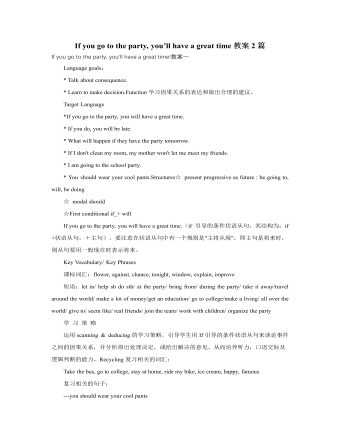
人教版新目标初中英语八年级下册If you go to the party, you’ll have a great time教案2篇
- 页数:25页
- |大小:200.00KB
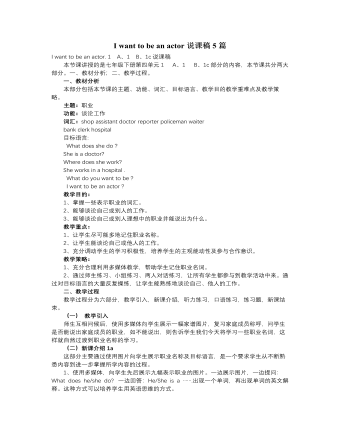
人教版新目标初中英语七年级下册I want to be an actor说课稿5篇
- 页数:10页
- |大小:81.50KB

人教版新目标初中英语八年级下册Why don’t you get her a scarf说课稿7篇
- 页数:31页
- |大小:446.50KB
热门说课稿
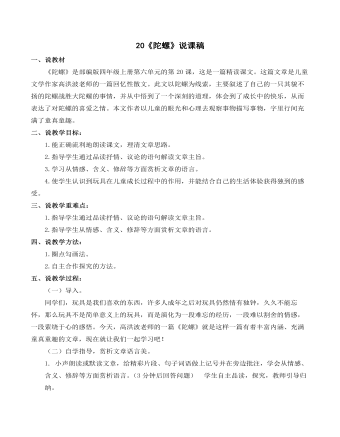
《陀螺》说课稿
- 页数:4页
- |大小:39.00KB
- 说课稿
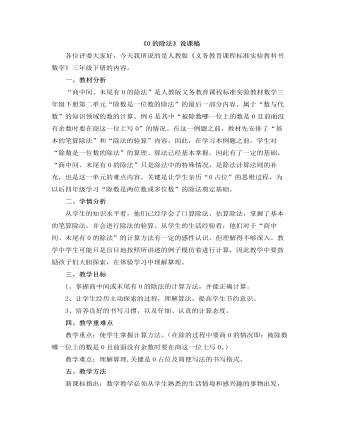
小学数学人教版三年级下册《0的除法》说课稿
- 页数:6页
- |大小:34.92KB
- 说课稿

高中历史人教版必修一《第22课祖国统一大业》说课稿
- 页数:3页
- |大小:46.07KB
- 说课稿
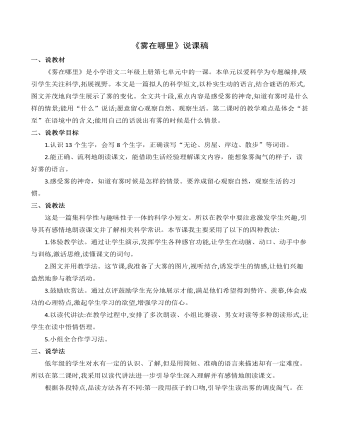
雾在哪里说课稿
- 页数:3页
- |大小:46.00KB
- 说课稿

小学数学人教版一年级上册《认识钟表》说课稿
- 页数:4页
- |大小:24.27KB
- 说课稿

中班健康《袋鼠跳》说课稿
- 页数:2页
- |大小:34.88KB
- 说课稿
今日更新

5月份主题教育工作情况总结汇报
- 页数:3页
- |大小:136.87KB

××县招商局2024年上半年工作总结
- 页数:12页
- |大小:142.54KB

×××公安局机关党委上半年党建工作总结
- 页数:7页
- |大小:186.25KB

《2019—2024年全国党政领导班子建设规划纲要》实施情况的工作总结3800字
- 页数:6页
- |大小:29.16KB

“转观念、勇担当、新征程、创一流”主题教育活动阶段性工作总结
- 页数:3页
- |大小:22.76KB

“四零”承诺服务创建工作总结
- 页数:5页
- |大小:39.83KB





